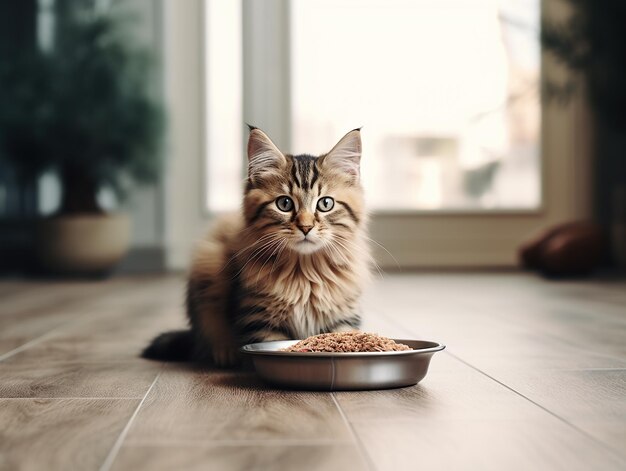Have you ever watched your feline friend meticulously scoop their kibble out of their bowl, only to delicately deposit it on the floor before finally consuming it? This peculiar behavior, while seemingly baffling at first glance, is actually quite common amongst our beloved cat companions. It’s a question that has puzzled cat owners for generations, and while there isn’t one definitive answer, exploring the potential reasons behind this quirky habit can shed light on the fascinating world of feline behavior.

Image: worldofdogz.com
This phenomenon, known to many cat owners as “food-flinging” or “eating off the floor,” isn’t just a case of messy eating habits. It’s a behavior rooted in a complex interplay of instinct, sensory preferences, and potentially even a touch of feline stubbornness. Understanding the motivations behind this peculiar choice can help us better understand our cats and, perhaps, even provide them with a more enriching and satisfying dining experience.
Unpacking the Mystery: Why Does My Cat Eat Off the Floor?
Let’s delve into the potential reasons why your cat might prefer the cold, hard floor to their perfectly fine, seemingly luxurious food bowl:
1. Instinctive Hunting Behavior
Cats are natural predators, and their hunting instincts run deep. Even domesticated cats retain these primal instincts, and eating on the floor may trigger a sense of “achievement” or “success” by mimicking the sensation of catching prey in the wild. They may even “bury” their food, instinctively mimicking the burying behavior of their wild ancestors.
2. Sensory Preferences
Just as humans have varied sensory preferences, cats also differ in their perception of textures and temperatures. Some cats may simply find the texture and temperature of the floor more appealing than the bowl. The colder temperature of the floor might make their food more appealing, perhaps mimicking the coolness of prey after a hunt.

Image: www.freepik.com
3. Disliking the Bowl
The bowl itself could be the culprit. Cats can be incredibly sensitive to their surroundings, and a bowl that’s too small, too large, too high, or made of an unappealing material could simply be unwelcoming.
4. Environmental Factors
Cats are sensitive to their environment, and factors like the position of the bowl, potential distractions, or even the presence of other animals can influence their eating behavior.
5. Food Preferences
Cats are notoriously picky eaters, and this can extend beyond the type of food to include where they consume it. Some cats might have specific texture or temperature preferences that a bowl doesn’t accommodate.
6. A Touch of Stubbornness
As anyone who has owned a cat can attest, they can sometimes be creatures of habit – and this can extend to the way they eat. Some cats simply prefer eating on the floor, and despite efforts to redirect their behavior, they might stick to their preferred dining spot.
Understanding the Implications for Your Cat
While your cat’s preference for the floor might seem amusing or endearing, it’s essential to address it, especially when it comes to maintaining their health and well-being. Eating off the floor presents several potential challenges:
-
Hygiene Issues: The floor is significantly less sanitary than a designated food bowl. It can harbor bacteria, dirt, and other contaminants that could make your cat ill.
-
Accidental Ingestion: Cats may inadvertently ingest foreign objects while eating from the floor – pebbles, dust, or even hairballs.
-
Behavioral Issues: Eating off the floor can be a habit that’s difficult to break, and it might even lead to other behavioral issues.
Tips for Encouraging Your Cat to Eat from Their Bowl
If your cat insists on eating off the floor, here are some tips to redirect them back to their bowl:
-
Bowl Selection: Experiment with different bowls, materials, shapes, and sizes to find one that your cat finds appealing.
-
Bowl Location: Choose a quiet, comfortable location for the bowl, away from distractions.
-
Food Variety: Offer a variety of textures and temperatures, perhaps even warming some food to see if that appeals to your cat.
-
Patience and Consistency: It takes time and patience to change a cat’s ingrained habits. Be persistent, and eventually, your cat may start to appreciate the convenience and hygiene of their bowl.
-
Consult Your Veterinarian: If you’re concerned about your cat’s eating habits or suspect any underlying health issues, always consult your veterinarian. They can help you rule out any potential medical causes and provide guidance on how to best manage your cat’s eating behaviors.
Cat Takes Food Out Of Bowl To Eat On Floor
A Deeper Understanding: Beyond the Bowl
Understanding why your cat might prefer the floor to their bowl isn’t just about addressing a messy eating habit. It’s about recognizing their instincts, appreciating their unique preferences, and fostering a deeper bond based on mutual respect and understanding. By taking the time to observe your cat’s behavior and adjusting their environment accordingly, you can contribute to their well-being and enrich their lives in profound ways.
Remember, every cat is an individual, and their behavior is a unique expression of their personality and experiences. Observing and understanding their motivations, even something as seemingly trivial as their eating habits, can unlock a deeper connection with these enigmatic and often misunderstood creatures.





